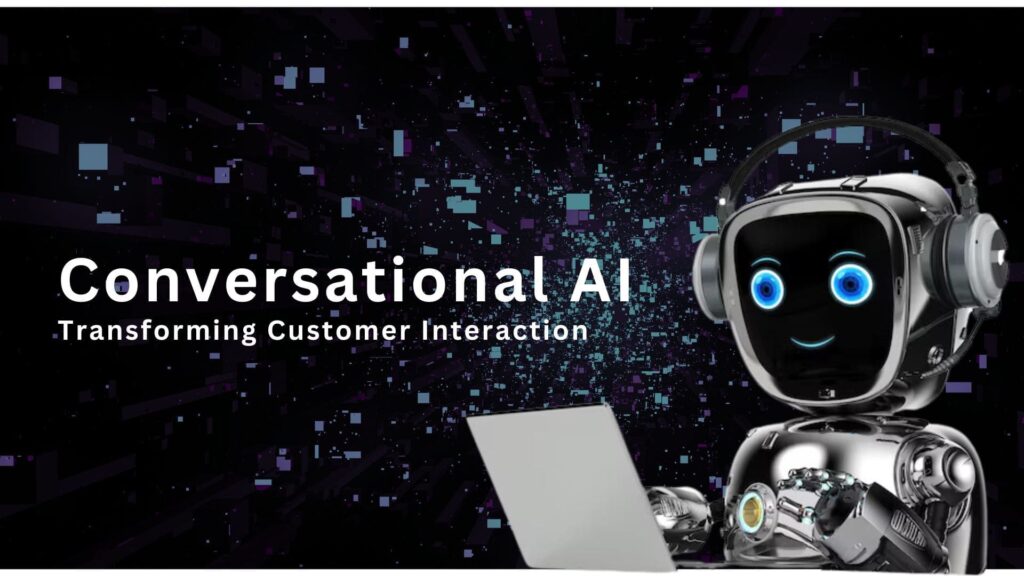Conversational AI can enhance customer communication, sales and marketing, employee experience, and by quickly and accurately responding to queries. It can be used to employ virtual assistants and cost-effective solutions to strengthen relationships with customers across digital channels. As AI becomes more common, businesses must learn how to leverage conversational AI for customer service, benefiting customers and agents and optimizing it for Customer Experience (CX).
What Is Conversational AI?
Conversational AI is a set of technologies that recognizes and responds to speech and text inputs, allowing businesses to communicate with customers and visitors according to their online persona.
It combines various communication technologies, platforms, and channels, providing dynamic and fluid response scenarios. Advanced voicebots combine different forms of AI for more capabilities, enabling businesses to deliver exceptional brand experiences across various channels and languages.
How Does Conversational AI Work?

Conversational AI can be compared to an advanced computer that can discuss things with you and comprehend your meaning, much like an actual human being.
A more technical explanation of conversational AI is provided here:
- Understanding what you say:
Conversational artificial intelligence (AI) systems use spoken and written input analysis and processing to break down words into smaller units. - Interpreting it:
Conversational AI employs Automated Speech Recognition (ASR) technology to interpret and generate machine-readable text after using natural language processing to comprehend words and recognize patterns, context, and emotions. - Choosing the appropriate response:
conversational AI quickly responds using memory, asking additional questions for more details, and using Dialog Management to formulate responses based on text comprehension. - Gaining knowledge and getting better:
Conversational AI improves with more users, gaining proficiency in various languages, accents, and slang through conversations, continuously improving over time. - Speaking in a human voice:
Conversational AI can respond naturally to human queries, chats, and jokes, using Natural Language Generation (NLG) for dialogue management. It aims to create a friendly and comprehensible conversation.
Moreover, text-to-speech or text-based responses are provided by conversational Al applications. The Al application interacts with the clients in the final step of the process, Reinforced Learning, to gain insight into their behavior and reaction patterns. Through experience, each interaction enhances the ongoing learning process.
Components of conversational AI

Advanced technologies like natural language processing (NLP) and machine learning are combined with conversational AI to create a system that can both understand human speech and respond to it in a human-like manner.
- Machine Learning (ML): Machine Learning (ML) is a sub-field of artificial intelligence that uses complex algorithms to identify patterns from large data sets and make predictions. It’s crucial for conversation AI engines to continuously learn from data and improve their understanding of human language responses.
- Natural Language Processing (NLP): Natural Language Processing (NLP) is a machine learning technique used in conversational AI to analyze language and transform unstructured data into machine-readable formats, with deep learning expected to enhance its capabilities in the future.
- Data mining: Unlike machine learning, which concentrates on making predictions based on recent data, data mining is an essential part of conversation AI engines, allowing developers to find patterns and insights from conversational data.
- Automatic Speech Recognition (ASR): AI for voice-based conversations includes ASR, which uses speech-to-text to understand human voice inputs, eliminate background noise, infer questions, and mimic human responses in natural language dialogue and directed dialogue.
The Benefits Of Conversational AI
In recent years, conversational AI has become increasingly popular among businesses due to the internet’s exponential growth in usage. Companies need to establish personal connections with people to meet the growing demand of meeting customer expectations. A few advantages of conversational AI are as follows:
- Increase operational cost efficiency.
Conversational AI can help small and medium-sized businesses reduce costs by deploying an AI-based response system. This system optimizes the workforce, keeps budgets within pre-planned levels, and provides 24-hour chatbots and Voice Bot access.
It handles information-seeking and repetitive interactions, ensuring consistency and continuity in the customer experience. This cost-effective solution is ideal for businesses struggling with staffing issues. - Boost sales and customer engagement.
Conversational AI enhances customer loyalty by proactively engaging with them and providing product recommendations and promotions. With the rise of mobile devices, businesses must provide real-time information, reducing wait times and increasing satisfaction. Personalization features enable voicebots to cross-sell products not considered by customers
. - Enhance your adaptability
Conversational AI offers quicker responses to consumer inquiries than human customer service representatives. The prompt response system enhances customer experience by making customers feel more valued and cared for.
Furthermore, through repeated interactions, AI improves the system’s adaptability by utilizing machine-learning algorithms. - Scalability
Establishing the infrastructure needed to support conversational AI is quicker and less expensive than hiring and onboarding new staff, so conversational AI is also incredibly scalable. Conversational AI benefits products that enter new geographic markets or that experience unanticipated brief surges in demand, like the holidays. - Help current customer service agents.
Conversational AI tools can interact with your clients without requiring human oversight. Additionally, they can use distinct customer data sets to communicate with several customers at once. Therefore, they can be “taught” to perform repetitive and less important tasks without human intervention.
An AI voicebot, for instance, can assist customers in finding your store’s location or learning about their account balance. By saving time and effort, agents can handle more complex cases that need their attention.
Conversational ai voice assistants make customer interactions easier Use voicebots in your customer service department. AI-driven virtual assistants use speech recognition and natural language to have conversations with your coustomer. Through frequent queries and problems, customers can assist themselves. The consumer is transferred to a live agent with all the relevant background information if the issue is too complicated or requires human interaction.
Additionally, voicebots open new possibilities for upselling and cross-selling that increase revenue. Based on the interests and past interactions of the customer, they can provide tailored recommendations. Additionally, voicebots’ accuracy, quickness, and round-the-clock accessibility enhance the customer experience.
Use Cases Of Conversational AI
Conversational AI uses chatbots and voice assistants or Voicebot to provide automated customer support services, leveraging customer data and real-time analytics. These apps offer a human-like interaction, mimicking human intelligence in real-life scenarios.
However, their ability to parse data and provide intelligible solutions can benefit businesses, as their “learning ability” can give customers a near-human-like experience.
- Provides online customer support: AI voice bots are replacing human agents in customer journeys, offering personalized advice, cross-selling products, and suggesting sizes. They are used on e-commerce sites, messaging apps, and voice bot tasks. AI-based voice bots can minimize human intervention, respond faster to queries, handle repetitive tasks, and use past customer data to enhance customer experience.
- Health care: A conversational AI system can enhance accessibility and affordability by improving operational efficiency and streamlining administrative procedures like claim processing. It can also make healthcare services more accessible and accessible for patients.
- The HR process: Conversational AI can significantly improve employee training and onboarding processes, update employee information, and streamline other HR processes.
- Internet of Things (IoT) devices: Most households now have at least one IoT device, such as Alexa speakers, smartwatches, and cell phones. With widespread applications like Amazon Alexa, Apple Siri, and Google Home, these devices use automated speech recognition to interact with end users. The use of IoT devices is increasing exponentially, allowing seamless communication through automated speech recognition programs.
- Retail: AI-powered Voicebots provide 24/7 customer service, replacing traditional call centers and in-person visits, even during holidays. They are now available in Call center making customer support accessible beyond office hours, and enhancing customer experience and satisfaction.
- Banks: AI voicebots are being utilized by banks to handle complex requests, particularly in handling customers’ finances, by reducing human errors and providing precise and accurate responses to address concerns.
- Computer software: Conversational AI has made many tasks in an office setting easier, like spell checking and Google search autocomplete.
Take the next step
Haloocom is a leading provider of conversational AI platforms, including AI-powered Voice Bots for multilingual and omnichannel support. They offer analytics and insights to optimize conversational AI strategies. Haloocom’s AI-powered Voice Bot improves customer experiences by understanding 6+ Indian languages, connecting to existing systems, and deploying anywhere with enterprise security and scalability. The bot automates repetitive tasks and uses machine learning to resolve customer support issues efficiently.





